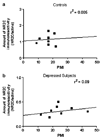Elevated levels of the NR2C subunit of the NMDA receptor in the locus coeruleus in depression
- PMID: 15920498
- PMCID: PMC2921564
- DOI: 10.1038/sj.npp.1300781
Elevated levels of the NR2C subunit of the NMDA receptor in the locus coeruleus in depression
Abstract
Low levels of the intracellular mediator of glutamate receptor activation, neuronal nitric oxide synthase (nNOS) were previously observed in locus coeruleus (LC) from subjects diagnosed with major depression. This finding implicates abnormalities in glutamate signaling in depression. Receptors responding to glutamate in the LC include ionotropic N-methyl-D-aspartate receptors (NMDARs). The functional NMDAR is a hetero-oligomeric structure composed of NR1 and NR2 (A-D) subunits. Tissue containing the LC and a nonlimbic LC projection area (cerebellum) was obtained from 13 and 9 matched pairs, respectively, of depressed subjects and control subjects lacking major psychiatric diagnoses. NMDAR subunit composition in the LC was evaluated in a psychiatrically normal subject. NR1 and NR2C subunit immunoreactivities in LC homogenates showed prominent bands at 120 and 135 kDa, respectively. In contrast to NRI and NR2C, very weak immunoreactivity of NR2A and NR2B subunits was observed in the LC. Possible changes in concentrations of NR1 and NR2C that might occur in depression were assessed in the LC and cerebellum. The overall amount of NR1 immunoreactivity was normal in the LC and cerebellum in depressed subjects. Amounts of NR2C protein were significantly higher (+ 61%, p = 0.003) in the LC and modestly, but not significantly, elevated in the cerebellum (+ 35%) of depressives as compared to matched controls. Higher levels of NR2C subunit implicate altered glutamatergic input to the LC in depressive disorders.
Figures







Similar articles
-
Glutamate signaling proteins and tyrosine hydroxylase in the locus coeruleus of alcoholics.J Psychiatr Res. 2008 Apr;42(5):348-55. doi: 10.1016/j.jpsychires.2007.02.010. Epub 2007 May 3. J Psychiatr Res. 2008. PMID: 17481661 Free PMC article.
-
Low nNOS protein in the locus coeruleus in major depression.J Neurochem. 2004 Dec;91(5):1057-66. doi: 10.1111/j.1471-4159.2004.02792.x. J Neurochem. 2004. PMID: 15569249 Free PMC article.
-
N-methyl-D-aspartate receptor subunit phenotypes of vagal afferent neurons in nodose ganglia of the rat.J Comp Neurol. 2006 Jun 20;496(6):877-85. doi: 10.1002/cne.20955. J Comp Neurol. 2006. PMID: 16628619 Free PMC article.
-
2-{[4-(4-[125I]Iodobenzyl)piperidin-1-yl]methyl}benzimidazol-5-ol.2011 Jan 31 [updated 2011 Mar 31]. In: Molecular Imaging and Contrast Agent Database (MICAD) [Internet]. Bethesda (MD): National Center for Biotechnology Information (US); 2004–2013. 2011 Jan 31 [updated 2011 Mar 31]. In: Molecular Imaging and Contrast Agent Database (MICAD) [Internet]. Bethesda (MD): National Center for Biotechnology Information (US); 2004–2013. PMID: 21473031 Free Books & Documents. Review.
-
N-[2-(N-(2-mercaptoethyl)) amino ethyl]-N-(2-mercaptoethyl)-3,5-dimethylacetamide amantadine-technetium.2012 Jun 12 [updated 2012 Jul 17]. In: Molecular Imaging and Contrast Agent Database (MICAD) [Internet]. Bethesda (MD): National Center for Biotechnology Information (US); 2004–2013. 2012 Jun 12 [updated 2012 Jul 17]. In: Molecular Imaging and Contrast Agent Database (MICAD) [Internet]. Bethesda (MD): National Center for Biotechnology Information (US); 2004–2013. PMID: 22812023 Free Books & Documents. Review.
Cited by
-
Magnetic resonance spectroscopy studies of glutamate-related abnormalities in mood disorders.Biol Psychiatry. 2010 Nov 1;68(9):785-94. doi: 10.1016/j.biopsych.2010.06.016. Epub 2010 Aug 21. Biol Psychiatry. 2010. PMID: 20728076 Free PMC article. Review.
-
The role of the central noradrenergic system in behavioral inhibition.Brain Res Rev. 2011 Jun 24;67(1-2):193-208. doi: 10.1016/j.brainresrev.2011.02.002. Epub 2011 Mar 5. Brain Res Rev. 2011. PMID: 21315760 Free PMC article. Review.
-
A brief history of the development of antidepressant drugs: from monoamines to glutamate.Exp Clin Psychopharmacol. 2015 Feb;23(1):1-21. doi: 10.1037/a0038550. Exp Clin Psychopharmacol. 2015. PMID: 25643025 Free PMC article. Review.
-
A scientometric analysis of research on the role of NMDA receptor in the treatment of depression.Front Pharmacol. 2024 Jun 21;15:1394730. doi: 10.3389/fphar.2024.1394730. eCollection 2024. Front Pharmacol. 2024. PMID: 38974036 Free PMC article.
-
Brain NMDA Receptors in Schizophrenia and Depression.Biomolecules. 2020 Jun 23;10(6):947. doi: 10.3390/biom10060947. Biomolecules. 2020. PMID: 32585886 Free PMC article. Review.
References
-
- Allgaier C, Durmaz M, Muller D, Franke H, Poelchen W, Wirkner K, et al. Single-cell RT-PCR analysis of N-methyl-d-aspartate receptor subunit expression in rat locus coeruleus neurones. Naunyn Schmiedebergs Arch Pharmacol. 2001;363:120–123. - PubMed
-
- Altamura CA, Mauri MC, Ferrara A, Moro AR, D’Andrea G, Zamberlan F. Plasma and platelet excitatory amino acids in psychiatric disorders. Am J Psychiatry. 1993;150:1731–1733. - PubMed
-
- Aston-Jones G, Ennis M, Pieribone VA, Nickell WT, Shipley MT. The brain nucleus locus coeruleus: restricted afferent control of a broad efferent network. Science. 1986;234:734–737. - PubMed
-
- Aston-Jones G, Shipley MT, Chouvet G, Ennis M, Van Bockstaele E, Pieribone V, et al. Afferent regulation of locus coeruleus neurons: anatomy, physiology and pharmacology. Prog Brain Res. 1991;88:47–75. - PubMed
-
- Auer DP, Putz B, Kraft E, Lipinski B, Schill J, Holsboer F. Reduced glutamate in the anterior cingulate cortex in depression: an in vivo proton magnetic resonance spectroscopy study. Biol Psychiatry. 2000;47:305–313. - PubMed
Publication types
MeSH terms
Substances
Grants and funding
LinkOut - more resources
Full Text Sources
Medical

